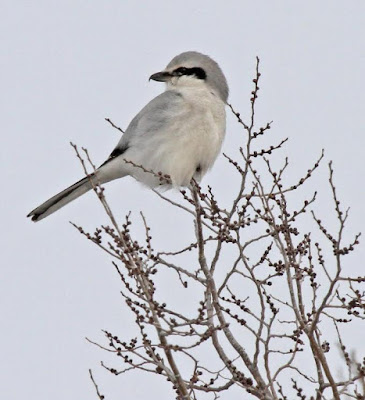 |
| Northern Sawhet Owl, courtesy of Laurie Koepke |
I have participated in the Regina CBC since 1985, but in the early '90s I started a Christmas Bird Count centred on the town of Craven. While the number of counters coming out to help at Craven has increased steadily over the years, perhaps the most remarkable change has come from the advent of digital photography.
Bird photography once required thousands of dollars worth of equipment, but recent developments in both digital SLR cameras and the even more affordable super-zoom cameras have made it a lot easier to get telephoto shots of birds.
Here are some photo highlights from the Craven and Regina CBCs. (Thanks to all the photographers who generously agreed to letting me use their photos in this post.)
First Craven, which was held on December 19.
We recorded 37 species (tying our highest record) including a Barrow's Goldeneye (no photo unfortunately), two Townsend's Solitaires and a Spotted Towhee.
Brian Sterenberg took this shot of one of the Townsend's Solitaires--in Phil and Louise Holloway's yard. Louise makes soup for the crew each year and we stop at their place for lunch, watching the many birds at their feeders as we warm up and compare notes for the morning.
 |
| Townsend's Solitaire courtesy of Brian Sterenberg |
Here is a shot of a large raptor that gave us some trouble initially. It flew over very briefly and I mis-identified it as a dark phase red-tailed hawk.
Once everyone got home and looked at their photos, though, it was clear that we had seen an adult Golden Eagle--the gold on the nape is visible in this image by Brian.
 |
| Golden Eagle courtesy of Brian Sterenberg |
White-breasted nuthatches occur at acreages and in the town of Lumsden where people feed birds. Thanks to Val Mann for this photo.
 |
| White-breasted Nuthatch, courtesy of Val Mann |
Another common feeder species is the Blue Jay. Nick Selinger, at 12 years of age, the youngest photographer on the count, took this lovely image.
 |
| Blue Jay, courtesy of Nick Selinger |
The Northern Shrike, a predatory songbird that eats mice, voles and smaller birds, visits the prairie each winter in small numbers. Thanks to Val Mann for this image.
It was a redpoll year so we counted several hundred on the Craven CBC. This photo of a nice rosy-breasted male was taken by Nick Selinger.
 |
| Common Redpoll, courtesy of Nick Selinger |
Fran Kerbs managed to find the only two Great Horned Owls on the Craven count. Here is one of the photos she took.
 |
| Great Horned Owl, courtesy of Fran Kerbs |
One last image from the Craven CBC--one of the rarest sightings of the day, a Spotted Towhee. This bird should have been hundreds of miles to the south but perhaps had lingered in its breeding precincts after an unusually warm fall and early winter.
Thanks to Hiro Aoki for getting this difficult shot of a very active bird.
 |
| Spotted Towhee, courtesy of Hiro Aoki |
Now for some photos from the Regina Christmas Bird Count, held on December 27. The compiler, Brett Quiring, is still getting data from counters but he tells me that it was a banner year for raptors. He is predicting a total well over 40 species of birds including several hawks and owls: Rough-legged Hawk, Bald Eagle, Northern Harrier, Gyrfalcon, Kestrel, a Cooper's Hawk, Merlin, Snowy and Great-horned Owl.
On December 30, within "count period," birder Laurie Koepke found another owl species in the city--a Northern Sawhet Owl. Here is a photo she was kind enough to share.
 |
| Northern Sawhet Owl, courtesy of Laurie Koepke |
But the stars of the Regina count were Rough-legged Hawks. We recorded 37 of them, including 14 in my sector alone. They are congregating near the city outskirts to the south-east, south, and south-west. At one point we pulled our car over along the traffic circle south of Highway 1 and west of Highway 6 and we counted seven in view all at once.
Most were hovering in the air, like this young, hatch-year bird photographed by Brian Sterenberg.
 |
| Rough-legged Hawk, courtesy of Brian Sterenberg |
Rough-legged Hawks have been recorded during the Regina count before but not in these numbers. They stay in this area when conditions favour their prey--mice and voles. The warm fall and light snow cover may have allowed numbers of these rodents to persist into December in some areas of the province, and the shallow snow cover allows a hover and pounce hunter like the Rough-legged to find them.
Perhaps the rarest bird on the Regina Count was a Red-bellied Woodpecker, which was good enough to show up at birder Dan Sawatzky's feeder just in time for to be counted. This photo was taken by Val Mann.
 |
| Red-bellied Woodpecker, courtesy of Val Mann |
Driving the back roads we found a small number of Horned Larks south of the city and west. This image was taken by Nick Selinger, who saw his very first Horned Larks that day.
 |
| Horned Lark, courtesy of Nick Selinger |
My favourite winter songbird is the Snow Bunting. It seems almost to relish the cold and stormy weather for you will often find the large flocks swirling and coursing over stubble fields and pastures like larger snow flakes borne on the wind. We came upon two large flocks, one totaling nearly a thousand birds. Brian Sterenberg took this image, showing one in flight and several on the ground feeding.
 |
| Snow Buntings, courtesy of Brian Sterenberg |
I will close with this video of a Snow Bunting flock. Though it is a bit rough, it shows some of the restless energy of these birds wintering here in the "south," a relative term because like the Snowy Owls, they breed in the high arctic.


























